Metric Kitchen: Cookware and Tools

These helpful measurement tools and tips will help you become confident and successful in your metric kitchen.
Kitchen Scale (gram, kilogram)
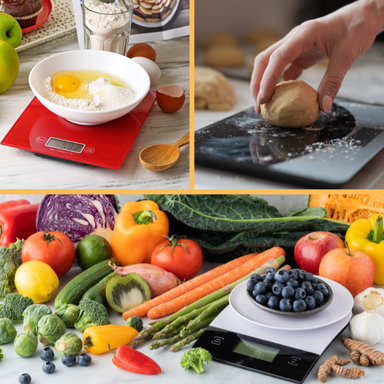
Credit:
Adobe Stock
- A digital kitchen scale is recommended to measure recipe ingredients in grams (or kilogram for large batches).
- Cooking and baking with a metric kitchen scale provides several benefits including:
- Accuracy. Measuring ingredients my weight rather than volume is more precise and consistent, ensuring repeatable results - recipes turn out the same way each time you make them.
- Time-saving. Measuring ingredients with a kitchen scale is faster and more efficient than measuring by volume, especially when dealing with small quantities or sticky ingredients like honey or molasses. Chefs may easily tare the scale to zero after adding each ingredient, without having to wash and dry multiple measuring cups or spoons.
- Better Results. Using a metric kitchen scale helps achieve better baking results. Baking is not only an art, but a science that requires precise measurements. Even a slight variation in ingredient quantities can affect the texture and taste of baked goods. A kitchen scale helps the chef ensure that the right amount of each ingredient is added, resulting in a perfect product.
- Versatility. A metric kitchen scale can be used for a variety of tasks, including measuring ingredients of cooking, baking, and making coffee. It can be used to weigh portions of food for portion control and healthy eating.
- Cost-effective. Using a metric kitchen scale can help save money by reducing food waste. When chefs measure ingredients accurately, they’re less likely to overuse or underuse ingredients, which can lead to spoiled or inedible food. This can help make the most of grocery purchases and reduce overall food expenses.
- Tips
- When purchasing a kitchen scale, consider the gross weight (ingredients + bowl) of the typical recipes that will be prepared in your kitchen to determine the ideal scale capacity. A 5 kg kitchen scale capacity is a common choice for home cooking. A larger kitchen scale capacity may be needed for commercial kitchens. A smaller capacity scale is handy for measuring smaller quantities, such as herbs and spices.
- Before each new measurement, press the “zero” to tare the kitchen scale to remove the gross weight of the bowl (or other vessel) and previously added ingredients so that the next ingredient can be dispensed onto the scale and easily measured. This process allows the chef to simply add the quantity of the next ingredient specified in the recipe.
- Do not mix ingredients when a bowl of ingredients is placed on the scale. To avoid damaging the kitchen scale always remove the bowl from the scale, place on a stable surface, then begin mixing.
Thermometer
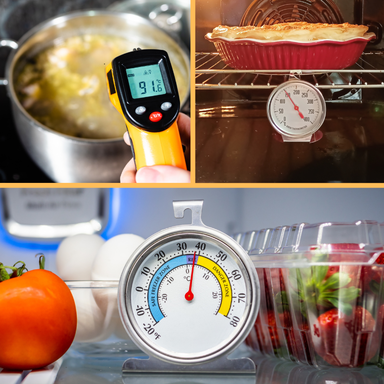
Credit:
Adobe Stock
- A cooking thermometer is an essential kitchen measurement tool. Cooking thermometers are invaluable for cooking, grilling, baking, and candy making.
- Food temperature is key to a successful recipe. For example, too high of a temperature may cause outer edges to burn while the inside remains uncooked. Cooking foods to appropriate temperatures eliminates harmful bacteria that cause illness and food poisoning.
- Tips
- Understanding your oven temperature is a baking best practice! Each oven, although similarly manufactured, will have temperature variations.
- A simple method to evaluate a cooking thermometer is to prepare a vessel of boiling water (100 °C, sea level), then read and record the displayed temperature. Calculate the difference. Make temperature adjustments according to the difference (e.g., add or subtract degrees and/or adapt cooking times, as needed).
- Consult more Culinary Temperature resources, including oven temperature equivalencies, common cooking temperature, candy making temperature, and safe minimal internal temperature.
Timer
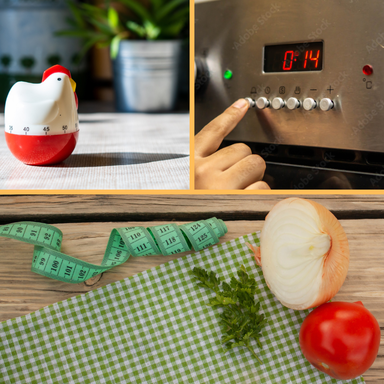
Credit:
Adobe Stock
- Use a timer for a variety of cooking tasks, such as boiling eggs, steaming vegetables, baking, or roasting. Using a timer can help avoid undercooking or overcooking food.
- When selecting a kitchen timer device, look for a clear and easy-to-read display, simple control settings, and loud alarm sound that can be heard in a noisy kitchen environment. Small buttons may be difficult for some users to press. Some timers have countdown and stopwatch timers. Multiple alarm capabilities are helpful when cooking several dishes at once.
- Tips
- Set the timer before you start cooking or baking so you don’t forget to start it or get distracted. It’s helpful to set a timer for a few minutes before the recipe suggests the food will be done to check on the progress and make adjustments, as necessary.
- Use multiple timers for complex recipes. When cooking a recipe with several steps or components, consider multiple timers to help keep track of everything. For example, set a timer for the vegetables to roast in the oven and another timer for the rice to cook on the stovetop.
- Test your timer’s accuracy. Before relying on a timer for critical recipes, test its accuracy by comparing it to another timer or clock to help ensure that you’re cooking and baking your food for the appropriate amount of time.
Metric Ruler
- A metric ruler is handy to determine the height of an oven rack, measure the dimensions before cutting a piece of cheesecloth for straining, or determining cookware dimensions described within a recipe.
- Metric rulers are available from many retail vendors, which can be identified by using search terms such as "metric rule" or "meter tape.” A classroom set of metric rulers are available to U.S. educators who request a free NIST SI Teacher Kit (while supplies last).
Estimate Bakeware Volume
- A quick method to measure the capacity of a baking dish is to use a kitchen scale in grams. Place the empty bakeware on your kitchen scale. Tare the scale to zero. Fill the bakeware up to the rim with tap water (don’t fill over the edge). Read the displayed weight to determine the pan volume. Remember, the density of water is about 1 g per mL. Example: If your full baking dish holds 1000 g of water, then your baking dish volume is about 1000 mL or 1 L.
Inside Measurement Dimensions | Approximate Volume | ||
|---|---|---|---|
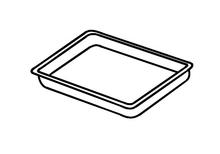
| Rectangle | 18 cm x 28 cm | 3 L |
| 23 cm x 33 cm | 3.5 L | ||
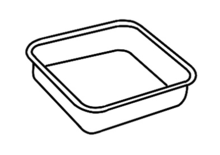
| Square | 20 cm x 20 cm | 2 L |
| 23 cm x 23 cm | 2.5 L | ||
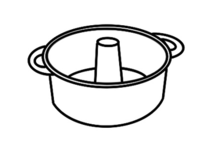
| Round | 20 cm | 1.2 L |
| 23 cm | 1.5 L | ||
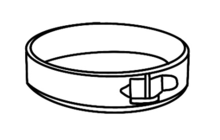
| Springform | 23 cm | 2.5 L |
| 27 cm | 3 L | ||
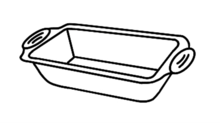
| Loaf Pan | 20 cm x 10 cm | 1.5 L |

| Loaf Pan (Deep) | 23 x 13 cm | 2 L |
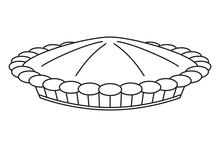
| Pie Plate | 23 cm | 1.25 L |
| Note: Artwork Credit: NIST/Dinelka Jagoda, except pie plate. Pie Plate Credit: Adobe Stock. | |||
METRIC COOKING CONNECTIONS
- Metric Kitchen
- Recipe Gallery
- Culinary Measurement Tips
- Culinary Temperature
- Cooking Equivalencies
- Special Publication (SP) 1290 - NIST Metric Recipes (2023) PDF
- Banana Bread (Video)
- Brownies (Video)
- Chocolate Chip Cookies (Video)
EXPLORE THE METRIC PROGRAM
Becoming Familiar with SI | Everyday Estimation | Metrication FAQs | Prefixes | Metric Kitchen | SI Education and Training | SI Publications | Understanding Metric | Writing with Metric Units | National Metric Week | NEST-R (STEM Registry) | NIST Education Resources
Disclaimer: Any mention of commercial products within NIST web pages is for information only; it does not imply recommendation or endorsement by NIST.
Contacts
-
Metric Program
-
General Information - OWM
Created March 1, 2023, Updated May 5, 2025

